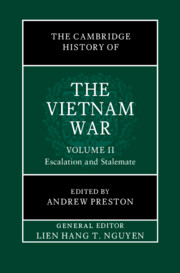Book contents
- The Cambridge History of the Vietnam War
- The Cambridge History of the Vietnam War
- The Cambridge History of the Vietnam War
- Copyright page
- Contents
- Figures
- Maps
- Tables
- Contributors to Volume II
- General Introduction
- Introduction
- Part I Battlefields
- 1 Reconsidering American Strategy in Vietnam
- 2 The Air Wars in Vietnam
- 3 US Combat Soldiers in Vietnam
- 4 American Women and the Vietnam War
- 5 The Conundrum of Pacification
- 6 The US Military Presence in South Vietnam
- 7 The ARVN Experience
- 8 The National Liberation Front
- 9 The People’s Army of Vietnam
- 10 Vietnamese Women and the War
- 11 Vietnam’s Ethnic Minorities at War
- 12 The War in Numbers
- 13 The Tet Offensive
- Part II Homefronts
- Part III Global Vietnam
- Index
5 - The Conundrum of Pacification
from Part I - Battlefields
Published online by Cambridge University Press: 02 January 2025
- The Cambridge History of the Vietnam War
- The Cambridge History of the Vietnam War
- The Cambridge History of the Vietnam War
- Copyright page
- Contents
- Figures
- Maps
- Tables
- Contributors to Volume II
- General Introduction
- Introduction
- Part I Battlefields
- 1 Reconsidering American Strategy in Vietnam
- 2 The Air Wars in Vietnam
- 3 US Combat Soldiers in Vietnam
- 4 American Women and the Vietnam War
- 5 The Conundrum of Pacification
- 6 The US Military Presence in South Vietnam
- 7 The ARVN Experience
- 8 The National Liberation Front
- 9 The People’s Army of Vietnam
- 10 Vietnamese Women and the War
- 11 Vietnam’s Ethnic Minorities at War
- 12 The War in Numbers
- 13 The Tet Offensive
- Part II Homefronts
- Part III Global Vietnam
- Index
Summary
The American War in Vietnam is often described as a struggle for the “hearts and minds” of the Vietamese people, a fundamentally political conflict in which “pacification,” the push to uproot the adversarys hold on the villages, became a primary mechanism in fighting the war. This chapter opens with an inquiry into the meaning of the terms of art, not just pacification but “counterinsurgency,” “civic action,” “nation-building,” and others. It observes this schema applies to an essential problem, the degree of South Vietnamese commitment to pacification, which remained problematic. To show this I start with a description of how pacification evolved under Ngo Dinh Diem and his successors. On the American side we see presidents, from Dwight D. Eisenhower, who took a conventional view, to John F. Kennedy, who applied counterinsurgency, to Lyndon B. Johnson, who championed the “other war,” one that privileged economic and social development. LBJ became the first to create an organizational structure to conduct pacification programs. The late-war innovations to these efforts, including measures of village loyalty, the Phoenix program attacking the National Liberation Fronts infrastructure, and the emphasis on elections from national to village level, were products of the Johnson administration. From the beginning, American pacification policy oscillated between emphasizing security versus social development before settling on security.
Keywords
- Type
- Chapter
- Information
- The Cambridge History of the Vietnam War , pp. 117 - 132Publisher: Cambridge University PressPrint publication year: 2024

